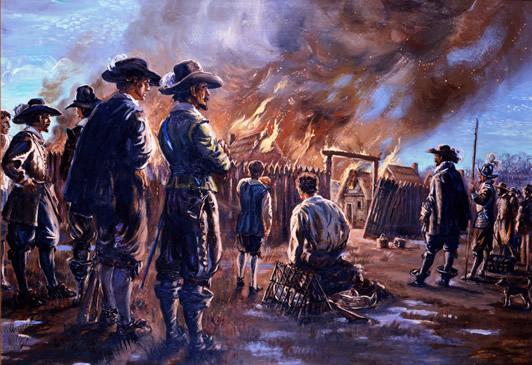 |
| Bacon confronting Gov. Berkeley |
This uprising, the most significant in British North America before the Revolution, occurred in Virginia in 1675–76. It was a result of colonial government corruption, declining opportunities for white immigrants, and increased conflict with Native Americans.
Since the late 1610s, Virginia had been a profitable enterprise for both tobacco planters and impoverished English men and women who came to America as indentured servants. By 1665, however, a decline in the price of tobacco and increased regulation of trade had brought the boom times to a halt.
By this point, the wealthiest planters, especially those allied with the royal governor Sir William Berkeley, had patented thousands of acres of land and were well suited to ride out the hard times.
  |
For small planters and recently freed servants, hard times coincided with a decline in the amount of available land and a high male to female ratio. “Six parts of seaven at least are Poore, Endebted, Discontented and Armed,” noted Berkeley, although he did little to mitigate the situation.
Instead, as landownership became less attainable, the government limited suffrage to property owners. Faced with a lack of opportunity and high taxes, poorer colonists rented land or headed to the frontier. As the latter group grew in number, it came into conflict with the Susquehannock Indians and war broke out in 1675.
Into this volatile situation came Nathaniel Bacon. A young and charismatic member of the English gentry, Bacon garnered a following among poor and frontier colonists by leading indiscriminate attacks on Native Americans. Berkeley worried that Bacon’s actions were hurtful to peaceful tribes and interfered with his monopoly over the fur trade.
 |
| Bacon burning Jamestown to the ground |
Accordingly, Berkeley denied Bacon a military commission to continue his war with Native Americans, but the growing unrest of the populace soon sent events spiraling out of control. On June 23, 1676, Bacon and four hundred armed men arrived in Jamestown and demanded that Berkeley accede to their demands.
However, once Bacon left town, Berkeley declared him a traitor, to which Bacon responded by twice chasing Berkeley out of the capital and burning Jamestown to the ground on September 18. A month later, Bacon fell ill and died, bringing the rebellion to an abrupt halt. His fellow conspirators were hanged the following spring, while Berkeley returned to England and died soon after.
In the short term, Bacon’s Rebellion changed little in Virginia society. Although political inequalities had been addressed during the uprising, many of these, including the expansion of the electorate, were rescinded thereafter.
   |
Poverty and a lack of opportunity remained prominent for at least another generation and it was less than a decade before another uprising broke out. In the long term, Bacon’s Rebellion further poisoned relations between colonists and Indians.
It also caused Virginia’s planters to realize that the success of a tobacco economy could not rest on a population of white servants for whom there was little opportunity for land ownership and a family once they finished their indentures. Indirectly, then, Bacon’s Rebellion became an impetus for the Chesapeake’s shift from white indentured servants to African slaves.